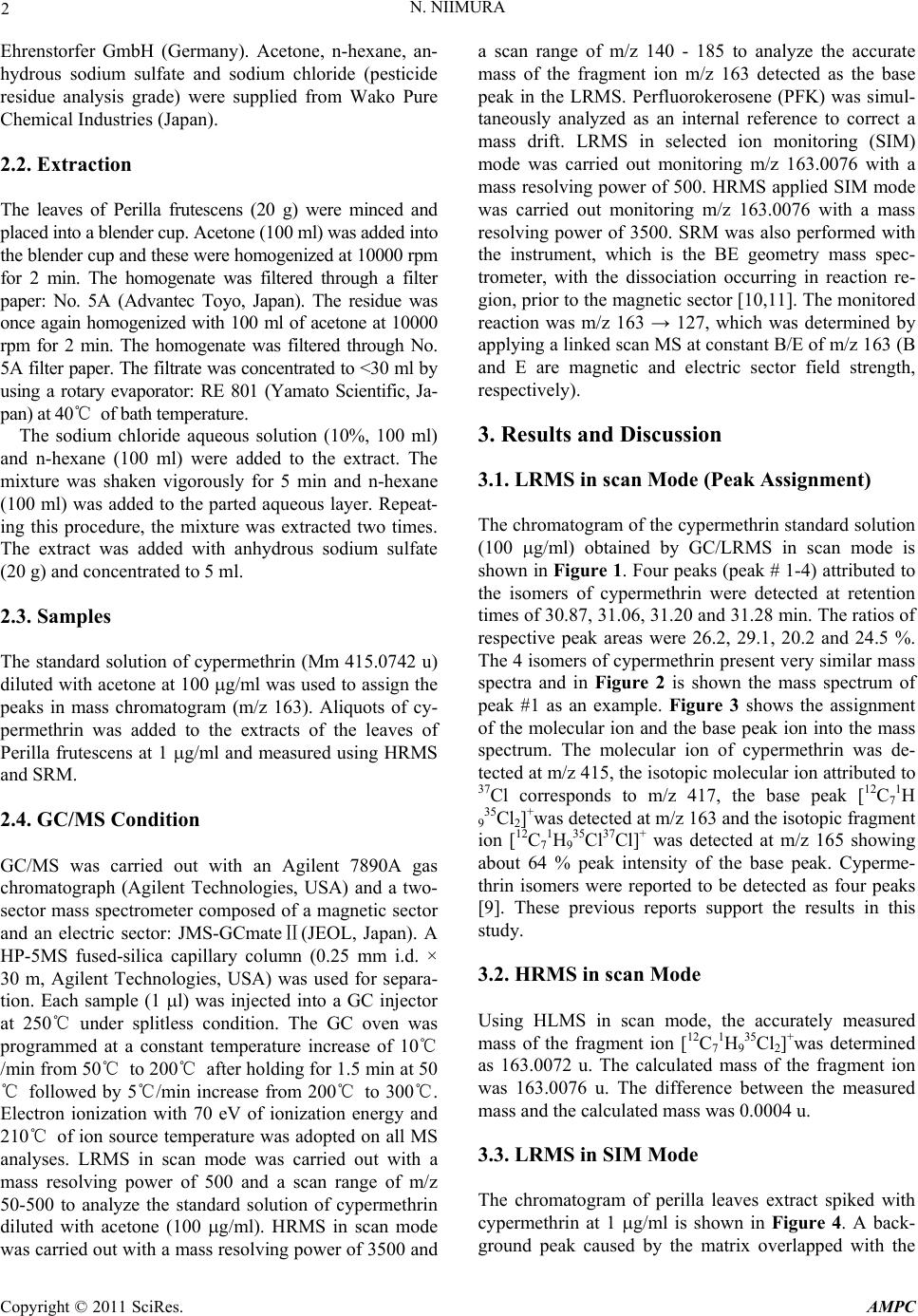
2 N. NIIMURA
Ehrenstorfer GmbH (Germany). Acetone, n-hexane, an-
hydrous sodium sulfate and sodium chloride (pesticide
residue analysis grade) were supplied from Wako Pure
Chemical Industries (Japan).
2.2. Extraction
The leaves of Perilla frutescens (20 g) were minced and
placed into a blender cup. Acetone (100 ml) was added into
the blender cup and these were homogenized at 10000 rpm
for 2 min. The homogenate was filtered through a filter
paper: No. 5A (Advantec Toyo, Japan). The residue was
once again homogenized with 100 ml of acetone at 10000
rpm for 2 min. The homogenate was filtered through No.
5A filter paper. The filtrate was concentrated to <30 ml by
using a rotary evaporator: RE 801 (Yamato Scientific, Ja-
pan) at 40℃ of bath temperature.
The sodium chloride aqueous solution (10%, 100 ml)
and n-hexane (100 ml) were added to the extract. The
mixture was shaken vigorously for 5 min and n-hexane
(100 ml) was added to the parted aqueous layer. Repeat-
ing this procedure, the mixture was extracted two times.
The extract was added with anhydrous sodium sulfate
(20 g) and concentrated to 5 ml.
2.3. Samples
The standard solution of cypermethrin (Mm 415.0742 u)
diluted with acetone at 100 g/ml was used to assign the
peaks in mass chromatogram (m/z 163). Aliquots of cy-
permethrin was added to the extracts of the leaves of
Perilla frutescens at 1 g/ml and measured using HRMS
and SRM.
2.4. GC/MS Condition
GC/MS was carried out with an Agilent 7890A gas
chromatograph (Agilent Technologies, USA) and a two-
sector mass spectrometer composed of a magnetic sector
and an electric sector: JMS-GCmateⅡ(JEOL, Japan). A
HP-5MS fused-silica capillary column (0.25 mm i.d. ×
30 m, Agilent Technologies, USA) was used for separa-
tion. Each sample (1 l) was injected into a GC injector
at 250℃ under splitless condition. The GC oven was
programmed at a constant temperature increase of 10℃
/min from 50℃ to 200℃ after holding for 1.5 min at 50
℃ followed by 5℃/min increase from 200℃ to 300℃.
Electron ionization with 70 eV of ionization energy and
210℃ of ion source temperature was adopted on all MS
analyses. LRMS in scan mode was carried out with a
mass resolving power of 500 and a scan range of m/z
50-500 to analyze the standard solution of cypermethrin
diluted with acetone (100 g/ml). HRMS in scan mode
was carried out with a mass resolving power of 3500 and
a scan range of m/z 140 - 185 to analyze the accurate
mass of the fragment ion m/z 163 detected as the base
peak in the LRMS. Perfluorokerosene (PFK) was simul-
taneously analyzed as an internal reference to correct a
mass drift. LRMS in selected ion monitoring (SIM)
mode was carried out monitoring m/z 163.0076 with a
mass resolving power of 500. HRMS applied SIM mode
was carried out monitoring m/z 163.0076 with a mass
resolving power of 3500. SRM was also performed with
the instrument, which is the BE geometry mass spec-
trometer, with the dissociation occurring in reaction re-
gion, prior to the magnetic sector [10,11]. The monitored
reaction was m/z 163 → 127, which was determined by
applying a linked scan MS at constant B/E of m/z 163 (B
and E are magnetic and electric sector field strength,
respectively).
3. Results and Discussion
3.1. LRMS in scan Mode (Peak Assignment)
The chromatogram of the cypermethrin standard solution
(100 g/ml) obtained by GC/LRMS in scan mode is
shown in Figure 1. Four peaks (peak # 1-4) attributed to
the isomers of cypermethrin were detected at retention
times of 30.87, 31.06, 31.20 and 31.28 min. The ratios of
respective peak areas were 26.2, 29.1, 20.2 and 24.5 %.
The 4 isomers of cypermethrin present very similar mass
spectra and in Figure 2 is shown the mass spectrum of
peak #1 as an example. Figure 3 shows the assignment
of the molecular ion and the base peak ion into the mass
spectrum. The molecular ion of cypermethrin was de-
tected at m/z 415, the isotopic molecular ion attributed to
37Cl corresponds to m/z 417, the base peak [12C7
1H
9
35Cl2]+was detected at m/z 163 and the isotopic fragment
ion [12C7
1H9
35Cl37Cl]+ was detected at m/z 165 showing
about 64 % peak intensity of the base peak. Cyperme-
thrin isomers were reported to be detected as four peaks
[9]. These previous reports support the results in this
study.
3.2. HRMS in scan Mode
Using HLMS in scan mode, the accurately measured
mass of the fragment ion [12C7
1H9
35Cl2]+was determined
as 163.0072 u. The calculated mass of the fragment ion
was 163.0076 u. The difference between the measured
mass and the calculated mass was 0.0004 u.
3.3. LRMS in SIM Mode
The chromatogram of perilla leaves extract spiked with
cypermethrin at 1 g/ml is shown in Figure 4. A back-
ground peak caused by the matrix overlapped with the
Copyright © 2011 SciRes. AMPC